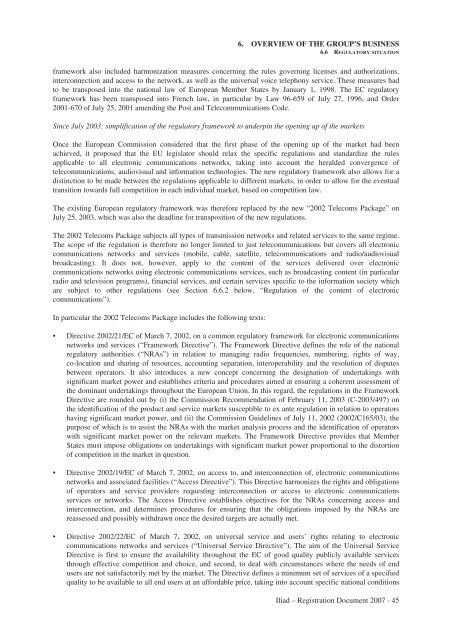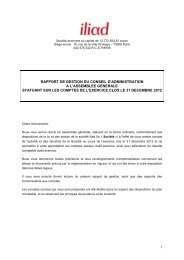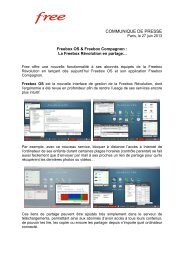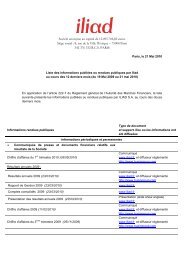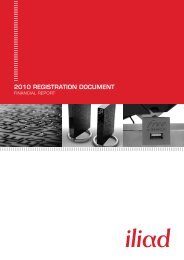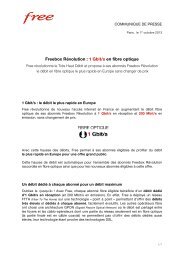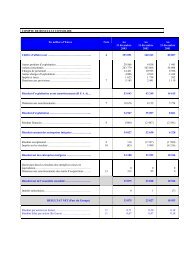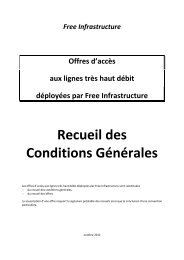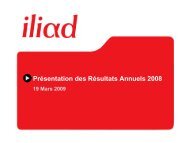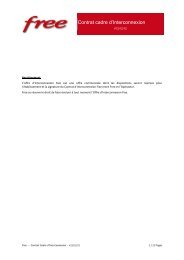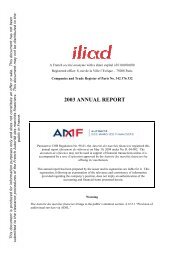REGISTRATION DOCUMENT AND FINANCIAL REPORT - Iliad
REGISTRATION DOCUMENT AND FINANCIAL REPORT - Iliad
REGISTRATION DOCUMENT AND FINANCIAL REPORT - Iliad
- TAGS
- registration
- iliad
- iliad.fr
Create successful ePaper yourself
Turn your PDF publications into a flip-book with our unique Google optimized e-Paper software.
6. OVERVIEW OF THE GROUP’S BUSINESS<br />
6.6 REGULATORY SITUATION<br />
framework also included harmonization measures concerning the rules governing licenses and authorizations,<br />
interconnection and access to the network, as well as the universal voice telephony service. These measures had<br />
to be transposed into the national law of European Member States by January 1, 1998. The EC regulatory<br />
framework has been transposed into French law, in particular by Law 96-659 of July 27, 1996, and Order<br />
2001-670 of July 25, 2001 amending the Post and Telecommunications Code.<br />
Since July 2003: simplification of the regulatory framework to underpin the opening up of the markets<br />
Once the European Commission considered that the first phase of the opening up of the market had been<br />
achieved, it proposed that the EU legislator should relax the specific regulations and standardize the rules<br />
applicable to all electronic communications networks, taking into account the heralded convergence of<br />
telecommunications, audiovisual and information technologies. The new regulatory framework also allows for a<br />
distinction to be made between the regulations applicable to different markets, in order to allow for the eventual<br />
transition towards full competition in each individual market, based on competition law.<br />
The existing European regulatory framework was therefore replaced by the new “2002 Telecoms Package” on<br />
July 25, 2003, which was also the deadline for transposition of the new regulations.<br />
The 2002 Telecoms Package subjects all types of transmission networks and related services to the same regime.<br />
The scope of the regulation is therefore no longer limited to just telecommunications but covers all electronic<br />
communications networks and services (mobile, cable, satellite, telecommunications and radio/audiovisual<br />
broadcasting). It does not, however, apply to the content of the services delivered over electronic<br />
communications networks using electronic communications services, such as broadcasting content (in particular<br />
radio and television programs), financial services, and certain services specific to the information society which<br />
are subject to other regulations (see Section 6.6.2 below, “Regulation of the content of electronic<br />
communications”).<br />
In particular the 2002 Telecoms Package includes the following texts:<br />
• Directive 2002/21/EC of March 7, 2002, on a common regulatory framework for electronic communications<br />
networks and services (“Framework Directive”). The Framework Directive defines the role of the national<br />
regulatory authorities (“NRAs”) in relation to managing radio frequencies, numbering, rights of way,<br />
co-location and sharing of resources, accounting separation, interoperability and the resolution of disputes<br />
between operators. It also introduces a new concept concerning the designation of undertakings with<br />
significant market power and establishes criteria and procedures aimed at ensuring a coherent assessment of<br />
the dominant undertakings throughout the European Union. In this regard, the regulations in the Framework<br />
Directive are rounded out by (i) the Commission Recommendation of February 11, 2003 (C-2003/497) on<br />
the identification of the product and service markets susceptible to ex ante regulation in relation to operators<br />
having significant market power, and (ii) the Commission Guidelines of July 11, 2002 (2002/C165/03), the<br />
purpose of which is to assist the NRAs with the market analysis process and the identification of operators<br />
with significant market power on the relevant markets. The Framework Directive provides that Member<br />
States must impose obligations on undertakings with significant market power proportional to the distortion<br />
of competition in the market in question.<br />
• Directive 2002/19/EC of March 7, 2002, on access to, and interconnection of, electronic communications<br />
networks and associated facilities (“Access Directive”). This Directive harmonizes the rights and obligations<br />
of operators and service providers requesting interconnection or access to electronic communications<br />
services or networks. The Access Directive establishes objectives for the NRAs concerning access and<br />
interconnection, and determines procedures for ensuring that the obligations imposed by the NRAs are<br />
reassessed and possibly withdrawn once the desired targets are actually met.<br />
• Directive 2002/22/EC of March 7, 2002, on universal service and users’ rights relating to electronic<br />
communications networks and services (“Universal Service Directive”). The aim of the Universal Service<br />
Directive is first to ensure the availability throughout the EC of good quality publicly available services<br />
through effective competition and choice, and second, to deal with circumstances where the needs of end<br />
users are not satisfactorily met by the market. The Directive defines a minimum set of services of a specified<br />
quality to be available to all end users at an affordable price, taking into account specific national conditions<br />
<strong>Iliad</strong> – Registration Document 2007 - 45


